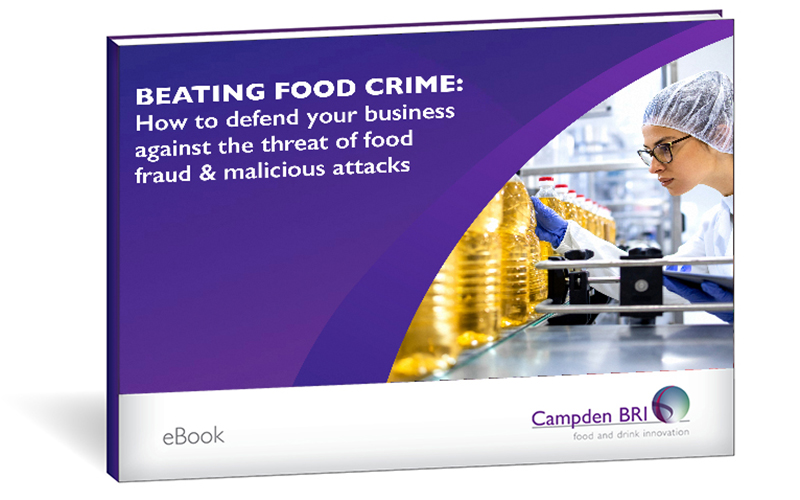
How to win the fight against food crime
21 June 2024 | Richard Leathers, Global Quality Lead and Bertrand Emond, Ambassador
The food crime threat
According to the Food Authenticity Network, food fraud costs the global food industry an estimated 40 billion US dollars annually.
Global geopolitical issues and climate challenges are having significant impacts on a wide range of raw materials and their supply chains. Shortages in availability of these raw materials are leading to substantial price increases and in some cases criminal activity, which in turn is posing a threat to the integrity, safety and quality of raw materials used across the industry.
The Food Standards Agency’s National Food Crime Unit (NFCU) works to prevent, detect and investigate food crime across the UK. It focuses its work on seven types of food crime:
- Illegal processing – slaughtering or preparing meat and related products in unapproved premises or using unauthorised techniques.
- Misrepresentation – marketing or labelling a product to wrongly portray its quality, safety, origin or freshness.
- Waste diversion – illegally diverting food, drink or feed meant for disposal, back into the supply chain.
- Substitution – replacing a food or ingredient with another substance that is similar but inferior.
- Document fraud – making, using or possessing false documents with the intent to sell or market a fraudulent or substandard product.
- Theft – dishonestly obtaining food, drink or feed products to profit from their use or sale
- Adulteration – including a foreign substance which is not on the product’s label to lower costs or fake a higher quality.
How to win the fight against food crime – our member event
Our food crime, member-only event in February 2024 focussed on the latest information and thinking on identifying and dealing with the threat of food fraud.
Expert speakers covered topics such as ethical business culture, food safety and quality culture, horizon scanning inputs, systems and outputs, intelligence sharing across the food and drink sector, food crime prevention and enforcement, developments in food authenticity testing, TACCP / VACCP, risk assessment and communication, and effective crisis management in the face of a food fraud incident.
This white paper summarises some of the key insights and updates shared during the event. Additional information and support can be sought through the contact details listed on the final page.
For more on overcoming the threat of food crime, download our ‘Beating Food Crime’ eBook on how to defend your business against the threat of food fraud and malicious attacks.
Download our FREE Beating Food Crime eBook today!
Win the fight against food crime – successfully defend your business against food fraud and malicious attacks.

From toxic corporate climates to adulterated foods
Saskia van Ruth (event Chair), University College Dublin
At the root of the food fraud dilemma lies not a microbe or a pollutant like with many food quality and safety issues, but rather a human adversary. It is the conscious decision made by individuals to transgress ethical boundaries, either for personal gain or on behalf of a company.
Those implicated in these frauds, predominantly criminal food professionals - not professional criminals, are governed by the prevailing culture and environment in which they operate. The ethical corporate culture of a business is a proxy measure of fraud, i.e. a weak culture can create a climate in which illicit activities flourish. Consequently, the ethical business cultures and food safety/quality cultures of your suppliers warrant careful consideration in the efforts to prevent food fraud.
Saskia presented her research, which indicates a strong correlation between a poor corporate climate and instances of offending behaviour in global food supply chains. This included tools for which ethical business culture can be measured.
A food industry perspective on food fraud – the risks, mitigation and monitoring
Kevin Barker, 2 Sisters Food Group
Challenges to the integrity of the feed and food supply chains has never been greater, and the need for robust horizon scanning processes have never been more critical.
Horizon scanning inputs may include the following types of information:
- Integrity, food safety and security;
- Climate and environment;
- Economic;
- Geopolitical;
- Legislation;
- Social;
- Supply chain;
- Other criminal activity.
Kevin outlined best horizon scanning practice, as well as the journey that 2 Sisters Food Group have been on to implement it.
All the key indicators need to be monitored closely if a clear understanding of the potential impacts are to be established. To support this important activity, there are platforms available for collating and analysing horizon scanning information. Furthermore, new technologies such as AI are also enabling the creation of new tools to analyse data and detect emerging issues.
A clear understanding of the risks provides an opportunity to implement effective control measures to mitigate the risks identified. Whilst many of these controls will by driven by individual businesses, there is also a great benefit in collaboration across the industry and supply chains in applying a joint approach to tackle these issues.
There is a need to factor in information on how fraudsters may try to circumvent detection via particular test methods. As such, food business operators also need to continue to explore opportunities to develop analytical methods. As our understanding of food fraud risks increases then it is essential that the analytical methods keep pace.
Businesses also need to stay abreast of regulatory changes, emerging trends, geopolitical issues, sudden price changes, their raw materials’ track record of previous fraud (i.e. a known high likelihood material), and the nature and key value/cost attributes of their raw materials.
As for all elements of the food safety management system, it is important that horizon scanning provides meaningful output (as opposed to being a ‘tick-box’, or ‘audit-passing’ exercise). A thorough, critical review of your system can be greatly beneficial – and this is often especially true when conducted by an independent, expert third party.
Joining forces: fiin, a collaborative approach to intelligence sharing
Sophie Lawrence, fiin
The role of intelligence sharing is a critical one when it comes to combatting fraudulent practices within the food system.
Established in 2015 by industry technical leaders, The Food Industry Intelligence Network (fiin) was created in response to the recommendation of the ‘Elliott Review’, for the industry to create a ‘safe-haven’ to collect, collate, analyse and disseminate information and intelligence to protect the interests of the consumer.
Sophie’s session confronted the challenges faced by the industry, examined practical aspects of intelligence sharing, and outlined fiin’s collaborative framework.
Data sharing benefits include:
- A more holistic supply chain picture;
- Opportunities to identify patterns, trends and emerging issues earlier;
- Pooling insights and resources, which facilitates intelligence-led solutions;
- Sharing best practices and new technologies.
fiin enables a collaborative and targeted approach to supply chain assurance. Its intelligence sharing mechanism enables both confidential intelligence sharing between industry members and partnership with government bodies to comprehensively understand potential risks within the UK food industry.
Membership gives companies access to quarterly data containing unique intelligence on food and drink authenticity, derived from the collated results of member testing and traceability exercises. Each year, over 50,000 authenticity tests are conducted and pooled for intelligence sharing, with 68 members currently involved in the network. The network also facilitates real-time notifications from fiin members and regulators on key issues. Insights from fiin enable its members to target their resources, so they can safeguard the integrity of their supply chains.
fiin has a mature intelligence sharing agreement with the UK regulators on industry challenges including the Food Standards Agency’s (FSA) National Food Crime Unit (NFCU), Food Safety Authority of Ireland (FSAI), and Food Standards Scotland (FSS), providing a structured process by which the industry and regulators can share information and better protect both the supply chain and consumers.
Membership is open to retailers, manufacturers and food service companies of any size, operating within the UK and Ireland. Join fiin and support their pioneering network in ensuring the UK is at the leading-edge in tackling food fraud. For more information, visit www.fiin.co.uk or contact fiin via email at fiin@campdenbri.co.uk
Food crime prevention
Ron McNaughton, Food Standards Scotland
Ron presented the new Food Standard Scotland’s (FSS’s) food crime prevention strategic plan. Central to this was the importance of working with key stakeholders to mitigate the risk of criminality impacting on food supply chains.
FSS and The Scottish Food Crime and Incidents Unit (SFCIU) have recently launched a Food Crime Risk Profiling Tool to support food business operators. For the rest of the UK, there is a Food Fraud Resilience Self-Assessment Tool from the Food Standards Agency (FSA).
Using these tools will help businesses to understand their risk from food crime and the measures that they can take to reduce this risk.

Developments in UK food authenticity research including detection challenges, and the Food Authenticity Network
Selvarani Elahi, LGC
Developments in UK food authenticity research including detection challenges
Verifying the authenticity of foods / detecting fraud in foods is not straightforward.
Unlike analytical test methods for food safety components, where testing is performed to check compliance against a legislative limit or some other recommendation such as maximum residue limits, food authenticity methods compare unknown samples against a reference set of ‘authentic’ samples. The challenge of obtaining traceable, internationally accepted reference samples for comparison, for the vast variety of foods that exist, remains one of the biggest challenges for food authenticity testing methods and is a barrier to the universal application / standardisation of methods.
Selvarani reported on the findings of three UK government funded research projects, which were:
- FSA Project on Herbs and Spices
- FSA Project on Point of Contact Technologies (in progress).
- Defra Project on Next Generation Sequencing (NGS) Analysis for Food Authenticity (in progress).
Supply chains for herbs and spices are complex and often international, and these raw materials are typically in the top 10 commodities most reported as being fraudulent . In Phase 1 of the FSA project on herbs and spices, a review of current and emerging methods of analysis for the determination of the authenticity of herbs and spice was undertaken. In Phase 2, a scoping exercise for the transfer of suitable methods to Public Analyst Official Laboratories (PA OLs) was conducted, and recommendations were made for future work.
Point of contact / point of use testing technologies involve portable analytical instrumentation that can be deployed throughout the food supply chain. They also offer the potential to screen samples quickly and cost effectively, and in non-laboratory environments.
NGS is a powerful emerging technology for food authenticity testing, with a variety of NGS platforms available with different capabilities and performance characteristics. However, variability of reported NGS results can cause confusion . There is also a need for harmonisation and standardisation of NGS approaches applicable for the verification of food authenticity, which is what the Department for Environment, Food and Rural Affairs (Defra) project aims to achieve.
The Food Authenticity Network
The Food Authenticity Network (FAN) was set-up in July 2015 by LGC, with funding from Defra, as a direct response to Recommendation 4 of the Elliott Review into the Integrity and Assurance of Food Supply, which highlighted the need for standardised testing approaches.
FAN is led by LGC and is funded using a public-private partnership approach and helps to build more resilient global food supply chains as it gathers information on food authenticity testing (Campden BRI is one of the Food Authenticity Centres of Expertise listed on FAN), food fraud mitigation and food supply chain integrity, in a structured manner, and disseminates it via its open access website. With all the relevant material together in one place it is much easier to access curated information and disseminate it to the community, enabling best practice information to be shared for the benefit of all stakeholders, helping to raise standards worldwide. In 2023, over 43,400 unique users accessed information on the FAN website.
A summary of activity in 2023 is available in English and Spanish with Chinese and French versions in production.
FAN is a one-stop-shop for anyone involved in food authenticity testing, food fraud prevention and supply chain integrity and, as such, will be of interest to scientists, the food industry, government, academia, enforcers and consumers alike. FAN is completely free to join so, if you’re not already a member, take a minute to join a community of almost 5,000 members worldwide, focussed on preventing food fraud.
Effective crisis response and insurance solutions in the event of a food fraud incident
Luke Withers, Lockton and Julia Johnson, Instinctif Partners
Julia focussed on the immediate impacts of a food fraud event and the potential financial and reputational damage that businesses can and do suffer. Luke then explored how insurance can provide financial relief, how policies are triggered and what aspects of a loss would be covered.
Food fraud related events, because of their link to financial motivation, are commonly perceived as not a covered risk by contamination insurance. This means examples like the ‘horsemeat scandal’ wouldn’t be covered necessarily on a standard wording, due to the lack of bodily injury threat. However, there is coverage for other examples of food fraud using the ‘Intentionally Impaired Ingredient’ trigger (i.e. cumin substituted with ground peanuts and the 2008 melamine scandal would be covered).
Recall and Replacement costs are a small part of the overall insurance claim for businesses affected by a food fraud incident. The biggest driver of loss is the reputational damage and subsequent cancellation of customer contracts or consequential loss. It is estimated that around 21% of consumers are inclined to buy products of other brands as a result of contamination incidents.
Allianz Insurance claims analysis reveals that the average cost of recall events for a food/drink business is EUR 1.3M and the average cost of a ‘significant’ event is EUR 8M.
Julia and Luke also covered some of the key elements of a successful response to a food fraud event and key points for businesses to consider for their crisis response to mitigate the impacts and protect their brand and reputation. A clear and tested crisis response is essential in mitigating the impacts.
A key takeaway message was that prevention is better than cure. In practice this means:
- Protecting reputation begins with the risk programme – TACCP and VACCP;
- Having a crisis team, recall process and crisis management system – including a communication plan;
- It is essential for food and drink business operators to stress test their crisis management system.
Best practice in risk assessment and communication, TACCP/VACCP
Richard Leathers, Campden BRI
Communication
Richard set the scene with some data from Oceana USA’s 2010-2012 seafood fraud investigation, demonstrating the large scale issue of mislabelling in this sector.
This was followed by a reminder of the Elliott Review’s systems approach based on eight pillars of food integrity, making clear that no one element can stand alone.
The pillars being:
- Consumers first;
- Zero tolerance;
- Intelligence gathering;
- Laboratory services;
- Audit;
- Government support;
- Leadership;
- Crisis management.
The result is a robust system that: puts the needs of consumers before all others; adopts a zero-tolerance approach to food crime; invests in intelligence gathering and sharing; supports resilient laboratory services that use standardised, validated methodologies; improves the efficiency and quality of audits and more actively investigates and tackles food crime; acknowledges the key role Government has to play in supporting industry; and reinforces the need for strong leadership and effective crisis management.
Perhaps most importantly, Richard focussed on how good communication (both within your own business, e.g. between technical and purchasing functions, and with suppliers) can help you to both identify potential risks and to ensure that meaningful action is taken across the business. Within businesses, this can be achieved through ‘huddle’ culture, and actively avoiding departments becoming ‘siloed’ from one another.
Data
Richard’s session also covered how to extract meaningful information from horizon scanning and other data, and how to know when to act. In relation to horizon scanning, according to the Food Standards Agency, successful detection of emerging risks requires four components:
- A protocol (framework);
- An intelligence strategy (when and where to look);
- Reliable data sources (validity);
- Skilled human intervention (know-how and common sense).
Horizon scanning sources discussed included the EU Rapid Alert System for Food and Feed (RASFF), Operation OPSON analysis reports, the Food Fraud Advisors’ Food Fraud Risk Information Database (hosted on Trello), and fiin. Key to managing the huge scale of information and potential action is the general principle that “80% of issues will be caused by 20% of your materials”, so it is important to identify where to focus your attention (through a systematic approach and robust threat and vulnerability plans – TACCP/VACCP).
TACCP/VACCP
PAS 96:2017 ‘Protecting and Defending Food and Drink From Deliberate Attack’ is a BSI guidance document that guides food business managers through approaches to improve the resilience of supply chains to fraud or other forms of attack. Richard Leathers (Global Quality Lead, Campden BRI) and Louise Harris (Safety & Quality Specialist, Campden BRI) are both part of the steering group for the 2024 review of PAS 96.
TACCP (Threat Assessment and Critical Control Points) is a system that has been developed in accordance with the steps and stages detailed in PAS 96. It is closely aligned with the methodology of HACCP, and is used to evaluate, document, understand and control the threats that may originate from issues of food fraud and food defence. VACCP (Vulnerability Assessment and Critical Control Point) relates to food fraud. Initial thinking on VACCP is that it would only cover food fraud (while TACCP would only cover food defence). In PAS 96, however, TACCP defines and covers both disciplines.
TACCP/VACCP is not ‘one size fits all’ – whilst PAS 96 covers both TACCP and VACCP together, many businesses may choose to cover them separately. Unlike HACCP, the scale of severity will also vary between businesses (where the risk posed is not one of food safety, severity will be subjective). The likelihood assessment for each risk will then be based on e.g. industry issues / history, country of origin, traceability information, confidence in supplier, level of uncertainty, and degree of non-detection.
Your TACCP/VACCP plans need to be dynamic, i.e. they cannot be a tick-box exercise that is only reviewed annually or only used to pass audits. They need to be reviewed – and a renewed mitigation strategy put in place – based on the changing and emerging risks affecting your supply chain.
Key points to consider include:
- Understand the historical perspective (i.e. lessons to be learnt from past incidents).
- A time lag between commencement and detection (i.e. it may be several months or even years between an initial food crime issue or incident, and it being identified and / or prevented).
- The value of certification / audit (i.e. if a site has GFSI-based systems in place, combined with regular supply chain and customer visits, we can be more confident due to those extra checks and balances in place).
- Adulteration often relates to the value or cost-determining product attributes (so consider how fraudsters may try to use / abuse this).
- Fraud is becoming more sophisticated (so you need to factor in information on how fraudsters may try to avoid detection, e.g. via particular test methods).
How we can help you to protect your business
We provide hands on support for businesses who want to better prepare for and address the threat of food fraud, malicious attacks and broader food crime. As such, we can help you to implement, validate and verify effective food safety management systems to protect your business.
We help businesses to identify emerging risks and trends through horizon scanning, and provide support with devising and adapting your management systems and monitoring plans based on the changing risk landscape.
As members of the Steering Group for PAS 96, including its 2024 review, we are best placed to support your implementation of this guidance and its latest updates.
Alongside this practical support, we provide a wide range of relevant training and can also analyse your products and materials to test for potential adulteration and other food fraud.
For more on overcoming the threat of food crime, download our ‘Beating Food Crime’ eBook.

About Richard Leathers
Richard Leathers joined Campden BRI in September 2011, and has worked in the food industry for 4 decades.
Richard started working with Dairy Crest and subsequently worked for both Heinz, Unilever, Best Foods and Kanes Foods. Working in the areas of HACCP and Quality Management Systems, Richard also has experience within the fresh produce sector, as well as analysis systems in the milling / baking areas, and is a BRCGS qualified lead auditor.
Richard has contributed to several publications and guidelines, including those for TACCP, VACCP and HACCP / Risk Evaluation and is also trained at advanced level by EHEDG (European Hygienic Engineering Design Group).

About Bertrand Emond
Bertrand has a wealth of knowledge, experience and connectivity from working here at Campden BRI since 1988. Bertrand has a Master's in Food Science & Technology (Dijon, France) and a Master's of Business Administration (Bath, UK).
Bertrand is passionate about supporting the industry in the areas of skills, knowledge, training, learning and development, competency and achieving culture excellence through behaviour change. He won the 2020 BRCGS CEO Europe Award recognising his commitment and contribution to food safety and the 2014 Heinz Award for Excellence for Leadership in Collaborative CPD for the Industry (in particular for his role in supporting competency and CPD, promoting the food industry as a career of choice, and providing collaboration between all stakeholders).
White paper download
Click below to download a copy of the white paper in PDF format
How can we help?
If you’d like to find out more about how we can support your business, contact out Support team.







